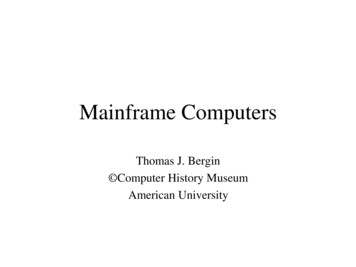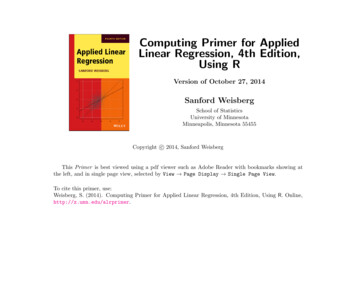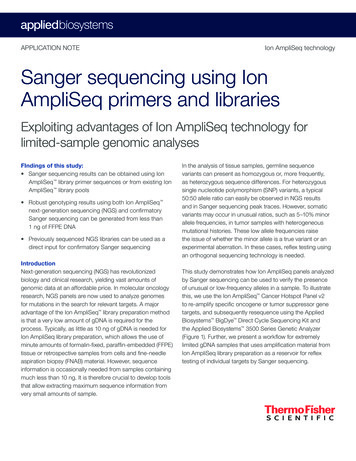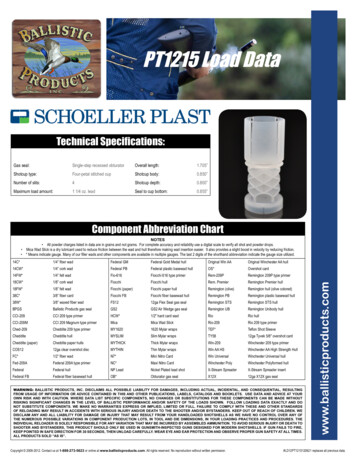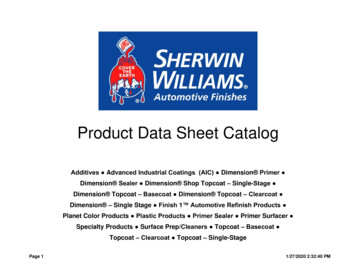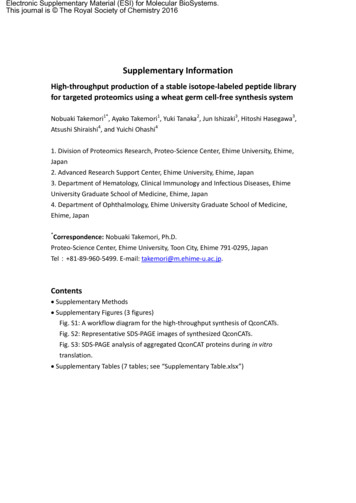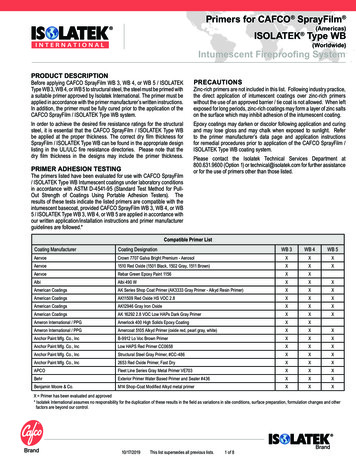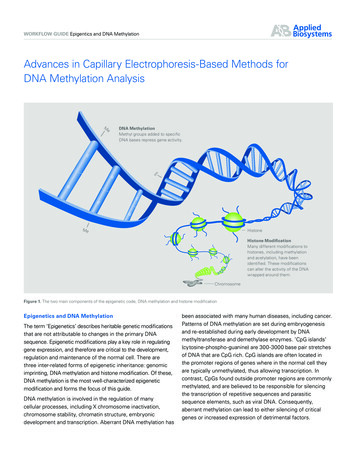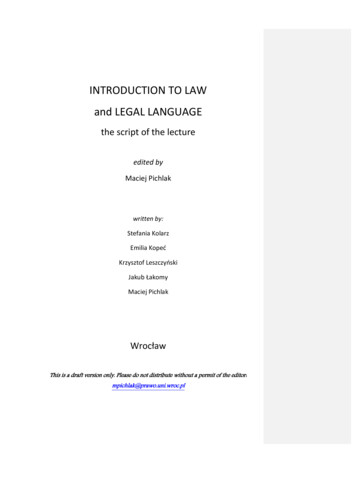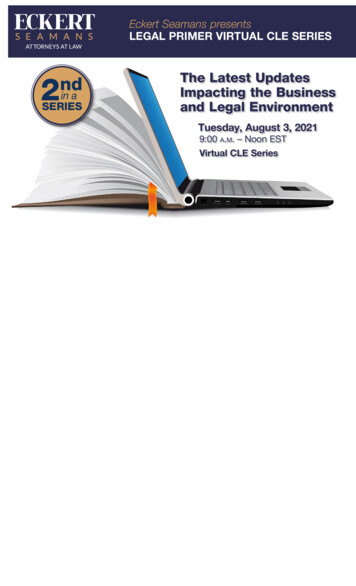
Transcription
Eckert Seamans presentsLEGAL PRIMER VIRTUAL CLE SERIES2ndin aSERIESThe Latest UpdatesImpacting the Businessand Legal EnvironmentTuesday, August 3, 20219:00 a.m. – Noon ESTVirtual CLE Series Approved by the Pennsylvania Continuing Legal Education Board for a total of three (3) hours of substantive law, practice,and procedure CLE distance learning credits (and states which offer reciprocity for PA-accredited programs).This year, Eckert Seamans’ LEGALPRIMER for corporate counsel andlegal professionals will be held virtuallyover a series of dates. Sign up forall of the sessions, or choose fromthe programs that most interest you.There is no cost to participate in thisCLE program, but pre-registration isrequired.Future dates and topics will beannounced at a later time.REGISTRATIONPlease click here.Upon completion of the registration form, aconfirmation email will be sent with the Zoomconnection details. Links are provided to add theinformation directly to your Outlook, Google, orother calendaring software.NOTE: Please register for the entire program, evenif your schedule only allows for viewing of onesegment, for example.If you encounter any registration difficultiesor have any questions, please contactkcromie@eckertseamans.com.9:00 a.m.“Business as Unusual”:Considerations for Employersin Year Two of the CoronavirusAMY Z. SNYDERIn the second year that employers grapple withCOVID-19, and as the nation slowly returns tothe physical worksite, the definition of “normal”in the workplace has shifted dramatically,and the impacts of the pandemic are likelyto dominate employment and labor law forthe foreseeable future. Relief legislation andother efforts carry important obligations, andevery business can expect changes in almostevery area of the employment relationship,including navigating new physical and virtualworkplaces. Whether your employees havebeen remote since 2020 or have alreadyreturned to the worksite, there remain manyrules, considerations, and best practices ofwhich employers should be aware, includingthose relating to ARPA and extension ofemergency paid sick leave and emergencyFMLA leave, safety protocols, vaccinationpolicies, assimilation issues, and navigatingpersonnel requests. This session will alsoexplore designing a flexible work schedulethat addresses employment, liability, and taximplications.10:00 a.m.Conducting EffectiveInternal InvestigationsAPRIL M. BYRD & V. AMANDA WITTSThere are many important questions and bestpractices to consider when undertaking aninternal investigation, including: determiningthe nature and scope of the investigation;appropriate investigative procedures;confidentiality and preserving privilege; witnessinterviews, pitfalls to avoid; ethical dilemmas;and internal investigations as a proactivetool to manage risk. This session will explorethese and other mission-critical questionsand strategies when performing an effectiveinternal investigation.11:00 a.m.Advertising and Marketing on theInternet: Dos and Don’tsRICHARD A. PEIRCEA misstep in advertising and marketing on theInternet that tarnishes a brand or damagesits relationship with consumers can becatastrophic. Guiding advertisers on complianceand avoiding liability is increasingly difficult,especially as advertising messages flow throughdifferent forums and platforms. This sessionwill explore various pitfalls in advertising andmarketing on the Internet, including intellectualproperty violations, false advertising, andthe avoidance of deception, as well as bestpractices for user-generated content andhandling unique issues with using someone’sname, image, and/or likeness online.The Pennsylvania Continuing Legal Education Board has approved the August 3 program for a total of three (3) hours of substantive law, practice, and procedure CLE distance learning credits.Eckert Seamans is an accredited provider for live, in-person and distance learning courses in Pennsylvania (and states that offer reciprocity for PA-accredited programs). As an accredited provider,Eckert Seamans must follow specific procedures set forth by the Pennsylvania Continuing Legal Education Board to verify distance learning attendance. Due to these requirements, presenters willshare attendance verification codes during each one-hour segment. Attendees will receive an email that includes a survey link to record the verification codes, so that we may verify and accuratelyreport your attendance to the PACLE.Eckert Seamans will report CLE credits earned to the Pennsylvania CLE Board. Attorneys may be eligible to receive CLE credit through reciprocity or attorney self-submission in other states; aUniform Certification of Attendance will be provided to those who must complete this process. In states where reciprocity does not apply, individual attendees are responsible for seeking courseapproval and must self-file with their state CLE boards. Please note that state CLE boards have the final authority to accept and grant CLE credit for individual courses.
“Business as Unusual”:Considerations for Employersin Year Two of the CoronavirusAmy Z. Snyder August 3, 2021www.eckertseamans.comwww.eckertseamans.com
Agenda In-Office Operations––––Safety protocolsLeave permitted and requiredVaccination policiesReturning onsite Extending or Introducing Flexible Work Schedules– Business needs vs. business culture– Remote work implications– Key components of a work-from-home policywww.eckertseamans.com
In-Office Operations Current Safety Protocols– Guidance from CDC and OSHA Masking Social distancing Sanitizing– State and local laws and guidance Examples: Washington, D.C., Philadelphiawww.eckertseamans.com
In-Office Operations Leave Laws– American Recovery Plan Act (ARPA) Voluntary Employers 500 employees Expands upon reasons for leave under Families FirstCoronavirus Relief Act (FFCRA) Extends the availability of tax credits for leave between April 1,2021 – September 30, 2021– State and local lawswww.eckertseamans.com
In-Office Operations Vaccination policies– Mandatory or voluntary– Employee legal challenges to mandatory vaccination policiesExamples Bridges v. Houston Methodist Hospital, Case No. 21-20311 (5th Cir.) Legaretta v. Macias et al., Civ. A. No. 21-00179 (D. N.M.) California Educators for Medical Freedom v. Beutner et al., Civ. A.No. 21-2388 (C.D. Cal.)www.eckertseamans.com
In-Office Operations Guidance issued by EEOC on vaccination policies– Americans with Disabilities Act Employer administration vs. third party administration Proof of vaccination– Reasonable accommodations under the ADA andTitle VIIwww.eckertseamans.com
In-Office Operations Vaccination policies, continued– Requests for accommodation due to a disability Undue hardship: significant difficulty or expense Direct threat analysis– Requests for accommodation of religious beliefs Sincerely held beliefs Undue hardship: more than de minimus cost or burdenwww.eckertseamans.com
In-Office Operations Implementing a vaccine policy– Consider alternate accommodations in light of currentcircumstances– Communicate decisions– Recordkeeping and Confidentialitywww.eckertseamans.com
In-Office Operations Implementing a vaccine policy, continued– Develop policies and procedures Educational campaign Expectations for obtaining a vaccine Consequences of not complying with policy How to request an accommodation for medical or religiousreasonswww.eckertseamans.com
In-Office Operations Assimilation of virtual workers back onsite– Communicate any changes in workflow, work environment– Address observed personnel issues/concerns Navigating personnel requests– Flexible scheduling– Use of accrued vacation/ PTO– Use of emotional support animals in the workplacewww.eckertseamans.com
Extending or Introducing Flexible WorkArrangements Assessment–––––Business needs and cultureExperience during government-ordered business closuresIndustry examplesClient expectationsOptionswww.eckertseamans.com
Extending or Introducing Flexible WorkArrangements Considerations for remote work– Employee performance and productivity Impact on collaboration Employee monitoring– Timekeeping Exempt vs. non-exempt employeeswww.eckertseamans.com
Extending or Introducing Flexible WorkArrangements Considerations for remote work, continued– Obtain tax advice specific to your business– Unemployment insurance Where to report wages and pay unemployment tax– Localization of service– Base of operations– Place of direction or control– Residencewww.eckertseamans.com
Extending or Introducing Flexible WorkArrangements Considerations for remote work, continued– Workers’ compensation Potential liability for injuries that occur at home Insurance coverage generally required where work islocalized State laws and applicable tests may varywww.eckertseamans.com
Extending or Introducing Flexible WorkArrangements Considerations for remote work, continued– State income tax withholding requirements vary Some neighboring states have reciprocal agreements Examples Pennsylvania and New JerseyX New York and New Jersey– “Convenience of the employer” rulewww.eckertseamans.com
Extending or Introducing Flexible WorkArrangements Key components of a remote work policy– Employee eligibility and suitability of positions– Trial periods and employer discretion to modify or revoke remotework arrangements– Use of employer-provided equipment– Information security and confidentialitywww.eckertseamans.com
Extending or Introducing Flexible WorkArrangements Key components of a remote work policy– Work hours and availability– Reporting time worked– Expectations for in-office meetings, travel– Business hours attirewww.eckertseamans.com
Thank you.Amy Z. ertseamans.comwww.eckertseamans.com
Best Practices in ConductingInternal InvestigationsDavid M. Laigaie and April M. Byrd August 3, 2021www.eckertseamans.comwww.eckertseamans.com
Rise in Internal Investigationswww.eckertseamans.com
Potential Liability for MisconductRisk Considerations Severity of alleged misconduct Single occurrence vs. pattern Ethical considerations Reputational Harm Financial ity m
Why Conduct Internal oveMoraleDO THERIGHTTHINGwww.eckertseamans.com
Triggers Internal complaints Whistleblowers Government proceedings or civillitigation Subpoenas Audits Board or Shareholder demandswww.eckertseamans.com
Warning SignsRed Flag udOverbillImproperwww.eckertseamans.com
Preparing for an gateAllegationTriagePlanningwww.eckertseamans.com
Preliminary Considerations Preserving confidentiality Likelihood of whistleblower Likelihood of reporting to Governmentand/or cooperation Conflicts of interest Potential litigation Preserving and collecting documentswww.eckertseamans.com
Who Will InvestigateInternal InvestigatorExternal Investigator Most familiar with the company Increased objectivity Familiar with the culture, personalities,and operation Perception of fair and independentinvestigation Known to management and employees Employees may be more willing to shareconcerns about management Less disruptive Likely increased experience Cost effective Increased protection of privilege (ifattorney)www.eckertseamans.com
Decisions, Decisions .Identify the point of contact for theinvestigationDefine the scope and (if applicable) the targetof the investigationSecure all digital forensic evidence – cellphones, laptops, tablets, cloud-baseddocuments – before conducting interviewsReview and tag all documents before sittingdown with key witnesseswww.eckertseamans.com
Organization as a Clientwww.eckertseamans.com
Preserving Privilege Must define role of counsel in advance Outside counsel investigationgenerally privileged unless used tomake personnel decisions Effect of assertion of privilege onlitigation In-house legal advisor andinvestigator: can’t have it both wayswith respect to privilegewww.eckertseamans.com
Preserving Privilege – In-house Documents Establish protocols for designating different types of communications Designate legal titles for legal personnel and include on letterhead/email signature blocks Remove business titles in privileged communications Limit sharing privileged communications internally or externally to those with need to know Include language that reflects that you are providing legal advice Separate legal advice from personal/business communicationswww.eckertseamans.com
Considerations in Light of #MeToo Movementwww.eckertseamans.com
Upjohn Warningswww.eckertseamans.com
Setting Up for Success Two interviewers Define scope of the interview Give proper Upjohn warnings and clearly explainrole Establish some initial rapport by starting withquestions about witness’ background and othergeneral topics Convey empathy Explain advantages of cooperation Make witness consider his/her loyalty to thecompany or people within itwww.eckertseamans.com
Interview Do’s and Don’tsDO: Outline all interview topics before conducting the interviewDO: Conduct all interviews in person, if possibleDO: Get acknowledgement that each Upjohn warning was heard andunderstoodDO: Remind employee of company policy on cooperation withinvestigationsDO: Ask open-ended questionswww.eckertseamans.com
Interview Do’s and Don’tsDO: Bring “hot docs” to interviewDO: Have a colleague take contemporaneous notes and put in amemorandumDO: Provide access to attorney if requestedDO: Keep the interview serious and business-likewww.eckertseamans.com
Interview Do’s and N’T:DON’T:Ever speak to a witness aloneTape-record the interviewProvide any type of legal adviceDiscuss the testimony of other witnessesMislead a witnessInterrogate witnessesDelay important interviewswww.eckertseamans.com
Concluding the Interview Anyone else you should talkto? Other documents you shouldreview? Anything you are missing,generally? Tell witnesses that if they haveany questions, to contact you,the attorney, and no one else Discuss no retaliation andconfidentialitywww.eckertseamans.com
Concluding the Investigation Oral or written report? How comprehensive shouldreport be? Memorialize the company’sgood-faith response to thefacts as they become known Promote a culture oftransparency throughout theorganizationwww.eckertseamans.com
When Investigations Go Wrong:Common Failureswww.eckertseamans.com
Using the Wrong Investigator PTC Three internalinvestigations did notuncover illegal scheme 28M DOJ/SECsettlement for FCPAviolationswww.eckertseamans.com
Circling the Wagons Wells Fargo Culture of disclosure v.culture of concealment Decentralizationwww.eckertseamans.com
Falling on the Sword Penn State Freeh Report Rolled over?www.eckertseamans.com
Who’s on First?www.eckertseamans.com
We Come to Praise Caesar, Not to Bury Him Weinstein Company Alleged misconduct wascommon knowledge withincompanywww.eckertseamans.com
Thank You, and Please Contact Us With AnyQuestionsDavid M. LaigaieApril M. ByrdMember, White Collar Defense s.comMember, Product Liability ckertseamans.com
Advertising and Marketing onthe Internet: Dos and Don’tsRich Peirce August 3, 2021www.eckertseamans.comwww.eckertseamans.com
Introduction The Internet changes some things, but not others. The very nature of the Internet’s speed and functionality doesnot always allow much room for analysis. Consumer expectations and the chase for any competitiveadvantage only shortens the time to contemplate the mostbasic and most complicated question “Can we do this?”www.eckertseamans.com
Pitfall – Identifying Trademark Issues Traditional trademark use on the Internet can be anything buttraditional. Are hashtags protectable as trademarks? What is username squatting (facebook.com/brand)? Domain names and why they are the same and different.www.eckertseamans.com
Pitfall - Protecting Your Marks Searches/clearance help avoid infringement and assessstrength. You are looking for third party use which is relevant in yourspace/industry. The availability of the relevant .com, other relevant domainnames, and social media user names must be tatus/delegatedstringswww.eckertseamans.com
Protecting Your Marks If feasible, pursue federal registration. The primary benefits includethe potential for nationwide rights, and the ability to put third partieson notice. ademark-basicsPolice the Internet, social media, and newly registered domainnames.You do not have to pursue every problematic use at the same time,but you do have to take steps to protect and enforce your brands.If you license your marks for others to use, you must make surethere are quality control mechanisms in place.www.eckertseamans.com
Protecting Your Marks If you need to sue for infringement/unfair competition, you willgenerally need to show that you have a protectable mark,priority of use over the alleged infringer, and a likelihood ofconsumer confusion (similarity of the marks andgoods/services, trade channels, actual confusion, intent,sophistication of buyers, etc.). Instances of Internet confusion are not always actionable. It may be ok for competitors to show up on Google searchesfor your name/brand.www.eckertseamans.com
Protecting Your Marks Can you go after third party sites that seem to help or contribute toan infringement?One type of secondary liability is contributory infringement. Is thethird party intentionally inducing infringement? Is the third partycontinuing to supply something to a direct infringer whom the thirdparty knows or has reason to know is engaging in infringingbehavior?Tiffany/eBay case No direct or indirect infringement. Generalknowledge of counterfeiting is not enough. The notice and takedown procedure was good, yet you cannot be willfully blind.www.eckertseamans.com
Protecting Your Marks What is cybersquatting? Has someone else registered andused a domain name that is similar to your mark? 15 U.S.C. § 1125(d) is the main cybersquatting portion of thetrademark statute. Is suing always best? Can you buy it? The Uniform Domain Name Dispute Resolution Policy(“UDRP”) provides an good alternate to litigation.www.eckertseamans.com
Pitfall – Use of a Competitor’s Mark Is a fair use being made of the mark? Is it nominative (e.g.,comparative advertising) or descriptive (Apple for apples)? Nominative Fair Use: (1) the product or service in questionmust be one not readily identifiable without use of the mark;(2) only so much of the mark may be used as is reasonablynecessary to identify the product or service; and (3) the usermust do nothing that would, in conjunction with the mark,suggest sponsorship or endorsement by the mark holder.www.eckertseamans.com
Pitfall – Use of Certification Marks These do not indicate the source of goods/services. These are not “used” by the owner of the mark. Instead, the mark can certify:– Geographic origin– Standards met as to quality or materials– That work is performed by a member of a certainorganization who meets certain standardswww.eckertseamans.com
Use of Certification Marks Certifying Body must be careful to:– Have concrete standards for certification– Apply the standards equally– Police use of the mark to protect against unauthorizeduse and maintain control over standards and use– Not use the mark as a trademark/service markwww.eckertseamans.com
Pitfall - Preventing Other Brand Damage Even deleted posts can be captured, circulated, andcommented on resulting in brand damage andembarrassment. What is your “public relations” plan ifsomething inappropriate gets posted? Do you have a policy in place for employees and socialmedia use? Who controls the passwords for applicable onlineaccounts? Are they kept in a vault?www.eckertseamans.com
Preventing Other Brand Damage Overreaction and other questionable IP and brand enforcementtactics can get you into trouble on social media. IP “bullies” can get exposed. All unauthorized uses of your content or brands are not alwaysinfringing uses, so be mindful of form enforcement.www.eckertseamans.com
Pitfall - Protecting Your Copyrighted Works What can be protected by copyright? Original works ofauthorship that are fixed in a set/tangible medium/format. This may include literary works, musical works including anyaccompanying lyrics, photos, graphics, and videos, to name afew.www.eckertseamans.com
Protecting Your Copyrighted Works Initial ownership vests in the author/creator. What are “Works Made for Hire?” The employer is considered theauthor in most circumstances if the work was created by anemployee as part of his/her work duties. What about independent contractors? Assignments are critical ifyou want to own the copyright rights.www.eckertseamans.com
Protecting Your Copyrighted Works Infringement - Anyone who violates any of the exclusive rights ofthe copyright owner is an infringer. This can involve makingunauthorized use and/or copies on the Internet. “Substantial similarity” and access is the test for infringement.www.eckertseamans.com
Protecting Your Copyrighted Works Can I go after a site or platform that is helping a directinfringer? Sometimes. Contributory infringement and inducement are alternatetheories of infringement. The test (1) knowledge of infringing activity; and (2) amaterial contribution. The Grokster case “one who distributes a device with theobject of promoting its use to infringe copyright, as shown byclear expression or other affirmative steps taken to fosterinfringement, is liable for the resulting acts ”www.eckertseamans.com
Protecting Your Copyrighted Works Removal of infringing material on a social media site can be donethrough the Digital Millennium Copyright Act. Most social media sites have a DMCA take down procedure inplace under 17 U.S.C.§ 512 of the Copyright Act.www.eckertseamans.com
Pitfall – Use of Someone Else’s CopyrightedWorks Use or publication on the Internet does not make it free touse. Simply because something can be right-clicked, copied, andpasted does not mean you should do so. Certain works can be tracked with digital watermarks. Difficulty in tracking down an owner does not change theequation. Circulation on social media is not an implied permission tocirculate elsewhere.www.eckertseamans.com
Use of Someone Else’s Copyrighted WorksHave you considered whether the use is fair?(1) The purpose and character of the use, including whethersuch use is of a commercial nature or is for nonprofit educationalpurposes (raw commercial use vs. something else);(2) The nature of the copyrighted work (creative vs. nonfictionwork);(3) The amount and substantiality of the portion used in relationto the copyrighted work as a whole; and(4) The effect of the use upon the potential market for or value ofthe copyrighted work.www.eckertseamans.com
Use of Someone Else’s Copyrighted Work What is parody? Use of some elements of an author’s work tocreate a new work that, at least in part, comments on theauthor’s work. What is satire? Use of a work to criticize or comment onsomething else.www.eckertseamans.com
Pitfall - False Advertising Federal law provides a cause of action for false advertising. False Advertising and Lanham Act (15 U.S.C. § 1125) “Any person who, on or in connection with any goods or services, orany container for goods, uses in commerce any false ormisleading description of fact, or false or misleading representationof fact, which (B) in commercial advertising or promotion,misrepresents the nature, characteristics, qualities, or geographicorigin of his or her or another person’s goods, services, orcommercial activities, shall be liable ”www.eckertseamans.com
False Advertising False or misleading statement of fact (e.g., “There are noheadphone manufacturers that provide more rebatesthan the Peirce Headphones). Statement made in interstate commerce in connectionwith commercial advertising or other promotional activity. Statement is a material statement that deceives or candeceive a substantial number of relevant consumers. Statement causes injury or is likely to cause injury.www.eckertseamans.com
False Advertising What about puffery or general assertions of superiority?Generally, not actionable. “We are better!” “This is the greatest set of headphones ever!!!”www.eckertseamans.com
Pitfall - Avoid Deception A deceptive advertisement or other marketing statementcould also get the attention of the FTC, state consumerprotection agencies, and/or other consumer protection orbusiness related trade groups. The avoidance of deception goes well beyond just theavoidance of blatantly false statements.www.eckertseamans.com
Avoid Deception Any specific disclosures or other requirements in the advertiser’sindustry (e.g., pharmaceutical, food)? Comparative advertising will get dissected by competitors for anyhints of false, deceptive, or misleading claims (whether explicit orimplied based on what is written or not written).www.eckertseamans.com
Avoid Deception The advertiser must make sure there is nothing at allfalse, deceptive, and/or misleading about thead/marketing material. This includes explicit or implied claims that could beinferred by relevant consumers. This includes claims or statements that could be deemedto be literally true, but by implication, cause relevantconsumers to draw a misleading conclusion.www.eckertseamans.com
Avoid Deception The advertiser must have strong substantiation to support mostclaims made in an ad. The more scientific or technical the claim, the moresubstantiation there should be for such claim. The substantiation must be legitimate substantiation that wouldstand up to industry scrutiny. The substantiation must be timely and up-to-date.www.eckertseamans.com
Avoid Deception Any product or service comparisons must use the samestandards, tests, processes, etc. for both the competitor’s andthe advertiser’s products/services. “Apples to apples” comparisons must be maintained.www.eckertseamans.com
Avoid Deception -The advertiser must avoid making certain claims where withoutmore clarification or details, the claims could be viewed as deceptive(omissions).All information about a product or service does not need to bedisclosed in every ad or marketing statement.An omission is problematic if it causes consumers to draw incorrectconclusions about a claim or generally misleads consumers aboutthe product or service.Was something omitted with the intent to deceive? Would theinclusion of the omitted information cause the consumer to not buythe product?www.eckertseamans.com
Avoid Deception The advertiser must not selectively highlight or focus on the“comparative advantages” of its goods in a way that could causeconsumers to draw incorrect inferences about a competitor’sgoods. EXCLUSIVE!!! The Peirce Headphones are waterproof and havenoise cancelling technology.www.eckertseamans.com
Avoid Deception The advertiser must not reference a deficiency in a competitor’sproduct while remaining silent if its own product has the samedeficiency. Why buy ABC Headphones for the beach they are not evenwaterproof!www.eckertseamans.com
Avoid Deception Any claims made in an ad must be relevant in normalsituations and not ones related to extreme or unusualsituations. The Peirce Headphones are waterproof and sweat proof in allsituations except if submerged in a body of water (not forwearing underwater). Yet, if headphones are only waterproofin light rain and not downpours, the ad is likely deceptive.www.eckertseamans.com
Avoid Deception Disclaimer or clarification language in a small font or that isotherwise hard to see or find will usually not be sufficient to makea prominent claim not deceptive or misleading (if such languageis needed). Any disclaimer or clarification language that is needed to make aclaim not deceptive must be conspicuous and prominent.www.eckertseamans.com
Pitfall – User Generated Content There may be situations where you will have to address usergenerated content in response to advertising and marketingyou post on social media and elsewhere. This may include social media comments, product/servicesfeedback in comments, and Google Reviews, to name a few. You may also be tempted to use some of this user generatedcontent in your future advertising and marketingmaterials/posts.www.eckertseamans.com
User Generated Content Defamation is a state law issue, so the legal definition will vary from state tostate. In general, defamation claims can involve analysis of: A false or defamatory communication made by the Defendant thatapplies to the Plaintiff. An understanding of its false nature by those who hear/see it. An understanding that the false statement applies to Plaintiff. Some level of harm or damages. No applicable defenses.www.eckertseamans.com
User Generated Content Social media and other platforms or sites that allow user generatedcontent will generally enjoy a broad immunity against liability for anyuser generated content that is defamatory (Section 230 ofCommunications Decency Act, 47 U.S.C. § 230). § 230(c)(1) (Treatment of publisher or speaker) - No provider or userof an interactive computer service shall be treated as the publisheror speaker of any information provided by ano
The Pennsylvania Continuing Legal Education Board has approved the August 3 program for a total of three (3) hours of substantive law, practice, and procedure CLE distance learning credits. Eckert Seamans is an accredited provider for live, in-person and distance learning courses in Pennsylvania (and states that offer reciprocity for PA .
